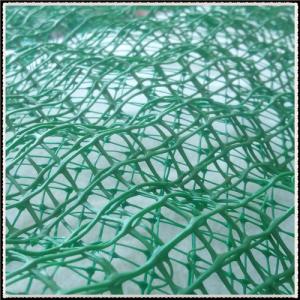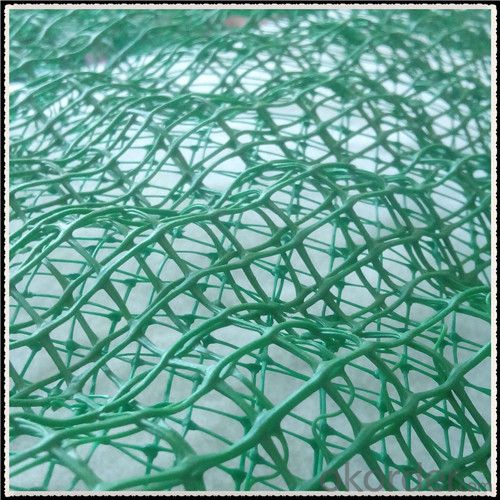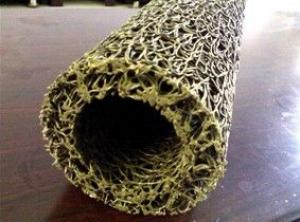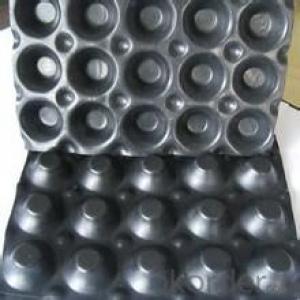Geonet or Geomat or Erosion Control Mat for Slope
- Loading Port:
- Qingdao
- Payment Terms:
- TT or LC
- Min Order Qty:
- 5000 m²
- Supply Capability:
- 100000 m²/month
OKorder Service Pledge
OKorder Financial Service
You Might Also Like
Geomat Description:
Geonet/Geomat is made from a kind of high-density polyethylene (HDPE) with properties of anti-aging and anticorrosion.
3D geomat erosion control mat is a kind of high polymer synthetic material made of 3D mesh structure, quality of a material is loose, flexible, with 90% of the space can fill soil,sand,the roots of the plants are grown through them balanced, the growth of grass make gauze pad, turf, soil surface firmly together, because the plant roots can be extended into the surface of the 30-50 cm, so the formation of a solid layer of green composite coating.

Geomat Specification:
CE121,CE131, CE151, DN1, HF10
Geomat Property:
1)Uniform structure, bear high pressure, improve the roadbed bearing capacity, enlarge its lifetime
2)Anti-aging, protect dam and rock surface from chemical erosion and sea water corrode.
Geomat Application:
1.Before the greensward grows, it prevents the surface of the land from the erosion of the wind and rain.
2 .Form compound protection layer with the vegetable, standing the wash-out of the high water level and large speed current.
3.Replace the concrete, asphalt, and block, using in the slope surface protection of roadway, railway, river-way, dyke, and the hillside, etc.
- Q: How are geosynthetic drainage composites used in earthwork applications?
- Geosynthetic drainage composites are used in earthwork applications to improve the drainage and filtration properties of soil. These composites consist of a geotextile fabric and a core of drainage material, such as a geonet or geospacer. They are installed within the soil to collect and transport excess water away from the area, preventing soil erosion and ensuring the stability of the structure. Additionally, they help to filter out fine particles from the water, maintaining the integrity of the drainage system. Overall, geosynthetic drainage composites play a crucial role in enhancing the performance and longevity of earthwork projects.
- Q: Civil engineering, machinery, materials and finance which relatively good employment? Good job prospects?
- Of course, is the civil ah I give you analysis of the material of the wide range of professional employment, but the depth is not enough wages ah what is not ideal employment rate is not too high (I am the material you do not be his name scared) unless you are Submit the material of the professional or you decide to study the future
- Q: What are the different materials used in earthwork products?
- The different materials used in earthwork products include soil, gravel, sand, crushed stone, clay, and various geosynthetic materials such as geotextiles, geogrids, and geocells.
- Q: Are there any specific earthwork products available for shoreline protection?
- Yes, there are specific earthwork products available for shoreline protection. These products include geotextiles, geogrids, erosion control blankets, and revetment systems. They are designed to stabilize and protect shorelines from erosion caused by waves, currents, and storm events.
- Q: Can earthwork products be used in ecological restoration projects?
- Yes, earthwork products can be used in ecological restoration projects. These products, such as soil, mulch, and rocks, can be utilized to create or restore habitats, improve soil quality, control erosion, and enhance biodiversity. They can help in the re-establishment of native plant species, promote wildlife habitat, and restore natural hydrological processes. Earthwork products play a crucial role in supporting the overall success and sustainability of ecological restoration projects.
- Q: How do earthwork products help with erosion control?
- Earthwork products help with erosion control by providing a physical barrier that prevents soil erosion. These products, such as geotextiles and geogrids, are designed to stabilize the soil, reinforce slopes, and control water flow. They effectively reduce the impact of erosive forces such as wind and water, preventing the loss of topsoil and protecting vulnerable areas.
- Q: Can earthwork products be used in slope stabilization projects?
- Yes, earthwork products can be used in slope stabilization projects. These products, such as geotextiles, geogrids, and geomats, are designed to reinforce and stabilize slopes by improving soil stability, preventing erosion, and enhancing drainage. They are commonly used in various slope stabilization applications, including embankments, retaining walls, and landslide mitigation projects.
- Q: Can geosynthetics be used for reinforcement in airport runways?
- Yes, geosynthetics can be used for reinforcement in airport runways. Geosynthetics such as geotextiles and geogrids can provide increased stability, reduce pavement cracking, and improve overall performance of airport runways. They are commonly used to enhance the strength and durability of the pavement, ensuring it can withstand heavy loads and traffic.
- Q: Are earthwork products suitable for golf course construction?
- Yes, earthwork products are suitable for golf course construction. Earthwork products such as topsoil, sand, and gravel are essential for shaping and building the golf course features like fairways, greens, and bunkers. These materials help create the desired contours, drainage systems, and playing conditions necessary for a well-designed and maintained golf course.
- Q: Can earthwork products be used in slope reinforcement?
- Yes, earthwork products can be used in slope reinforcement.
Send your message to us
Geonet or Geomat or Erosion Control Mat for Slope
- Loading Port:
- Qingdao
- Payment Terms:
- TT or LC
- Min Order Qty:
- 5000 m²
- Supply Capability:
- 100000 m²/month
OKorder Service Pledge
OKorder Financial Service
Similar products
Hot products
Hot Searches
Related keywords


























